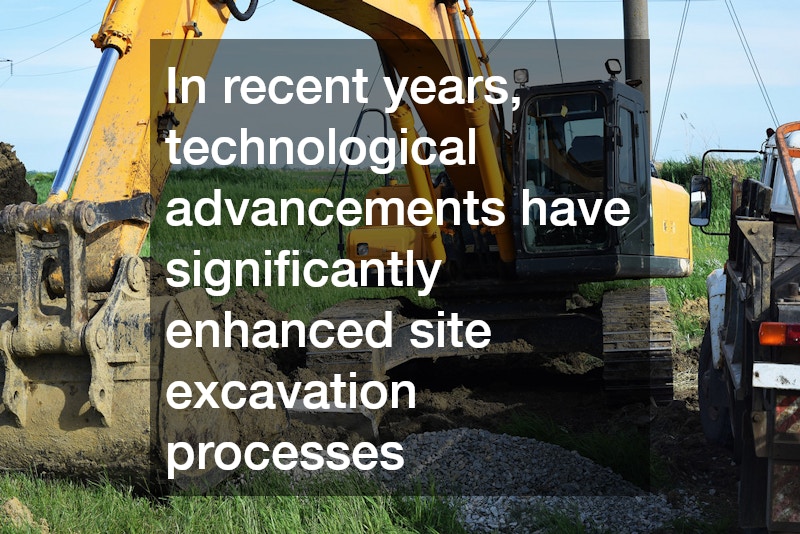The Importance of Site Excavation When Preparing for Construction
Site excavation is a critical step in the construction process, laying the foundation for a successful project. Explore the significance of excavation and the various aspects that must be considered during this phase of a construction project.
Before any structure can rise, the ground beneath it must be properly prepared—and that’s where site excavation comes in. Excavation is one of the most critical steps in any construction project, laying the foundation for safety, stability, and long-term success.
This process involves clearing, grading, and shaping the land to ensure that the site can support the weight and design of the planned structure. Professional excavation also helps identify and address potential issues such as poor soil quality, drainage problems, or underground obstacles before they disrupt the build. By investing in skilled site excavation, builders set the stage for efficient construction, structural integrity, and compliance with engineering and safety standards.
What Is Site Excavation and Why Is it Necessary?
Site excavation involves the process of digging, removing, and relocating earth, soil, and other materials from a construction site. This practice is integral to creating a stable base for building foundations, roadways, and landscaping. By removing unwanted materials, the site can be prepared for the essential structures that will follow.
Understanding the different elements involved in site excavation helps to clarify its necessity. Not only does it aid in shaping the land to fit the architectural plans, but it also ensures that any potential obstacles are dealt with before construction progresses. From soil types to existing underground utilities, thorough excavation helps prevent unexpected delays later in the project.
Furthermore, site excavation serves as the first step in addressing environmental factors. Excavation teams assess drainage issues, topography, and soil stability—all crucial aspects that can affect the longevity and integrity of a building. Without proper excavation, foundations may settle improperly, leading to costly repairs down the line.
What Are the Common Methods of Site Excavation?
Site excavation can employ various methods, each tailored to meet the unique demands of specific projects. Common techniques include open-cut excavation for large areas and trench excavation for more confined spaces. The choice of method depends on factors such as depth, material type, and the overall scope of the construction project.
Moreover, advanced excavation methods such as limited access excavation and vacuum excavation are gaining popularity, particularly in urban environments where space is tight and surrounding structures are at risk. These modern techniques greatly minimize disturbances and improve safety during the excavation process.
For successful project execution, knowing the correct excavation method is essential. Decisions on which method to use should consider not only the immediate benefits but also long-term implications for the surrounding environment and future construction processes.
What Are the Risks Associated with Improper Site Excavation?
Improper site excavation poses serious risks that can jeopardize the safety of construction workers and the integrity of the project. Key risks include soil collapses, equipment accidents, and damage to underground utilities. Each of these hazards can lead to significant delays and increased costs, further complicating project management.
Additionally, inadequate excavation can result in long-term structural issues. If the foundation is not built on properly compacted soil, it can lead to settling or shifting over time. This not only affects the safety of the building but also its longevity, thus increasing maintenance costs in the future.
Moreover, regulatory repercussions can arise from improper excavation practices. Adhering to local regulations ensures that all excavation work is compliant, helping to avoid fines or project halts. Proper management and oversight during excavation are essential to minimize these risks, reinforcing the foundational stability of the entire construction project.
How Can Technology Improve Site Excavation Processes?
In recent years, technological advancements have significantly enhanced site excavation processes. Innovations such as 3D modeling and GPS guidance systems allow for more precise excavation work, decreasing material waste and increasing overall accuracy. These systems make it easier to follow the specific site plans, improving efficiency and reducing the likelihood of errors.
Moreover, heavy machinery equipped with advanced technologies, such as automated excavators, can achieve higher productivity levels while reducing labor costs. These machines bring forth the ability to work continuously with fewer interruptions, thus streamlining the entire excavation process.
By adopting these technologies, construction teams can also improve safety during excavation activities. Automated systems can mitigate human error, decreasing workplace accidents and injuries. Embracing technology not only optimizes excavation efficiency but also fosters a safer environment for workers on site.
Site excavation is a foundational element that significantly influences the overall success of construction projects. By understanding its importance and addressing common inquiries, stakeholders can achieve better outcomes and safer environments.
Site excavation serves as the groundwork—literally and figuratively—for every successful construction project. A properly excavated site provides the stable, level base needed to support foundations, utilities, and landscaping features. It also prevents costly complications later on, such as settling, flooding, or erosion. Professional excavation ensures that each stage of construction can proceed smoothly, safely, and on schedule. Ultimately, the importance of site excavation lies in its ability to turn raw land into a build-ready foundation, paving the way for durable, high-quality structures that stand the test of time.

